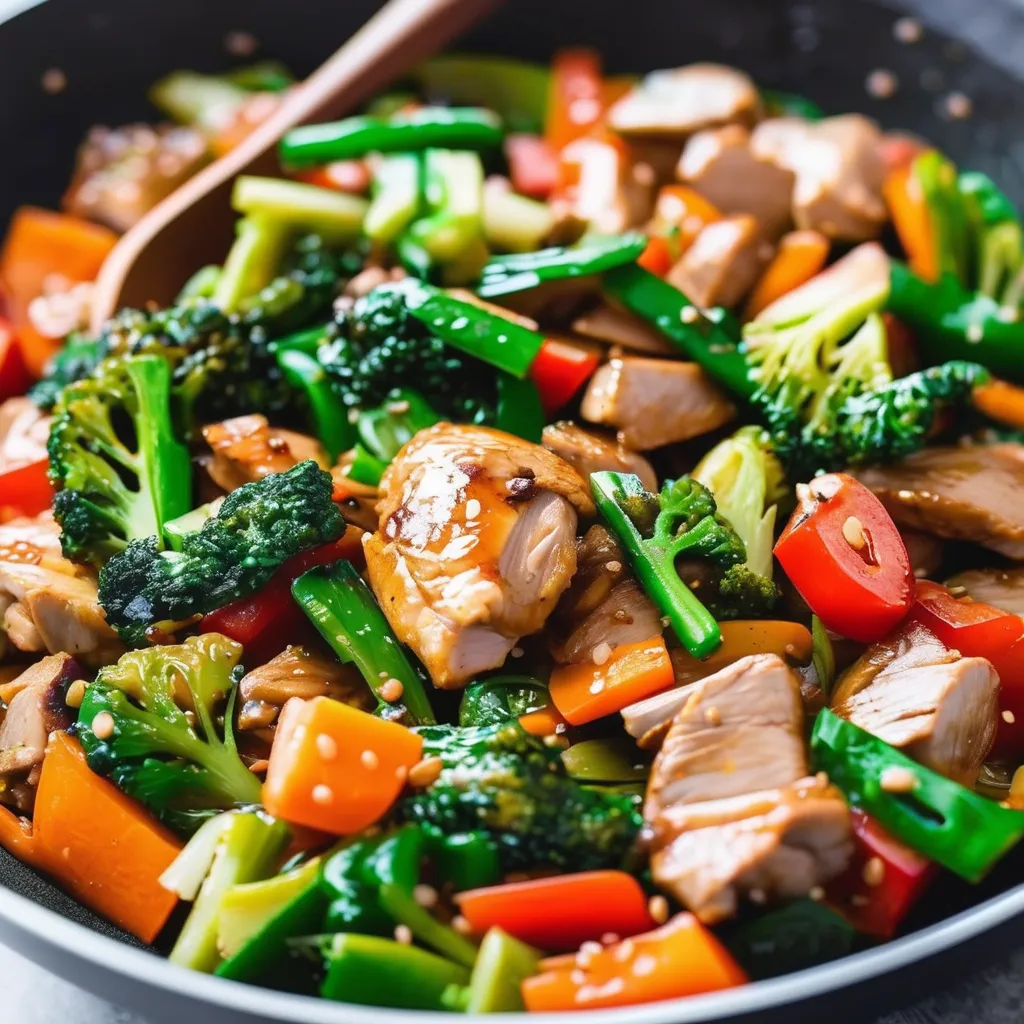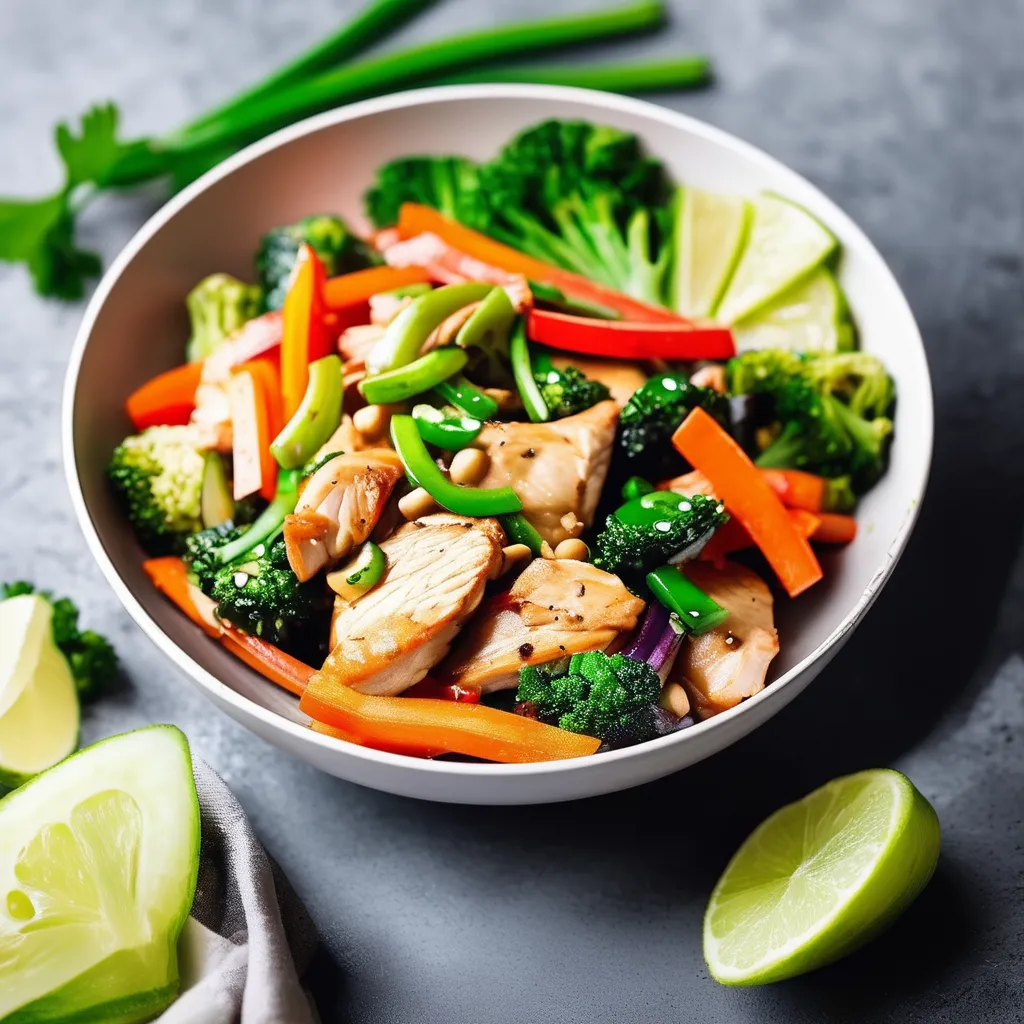Are you following a paleo diet and searching for a quick, healthy, and delicious dinner option? Look no further than this Paleo Chicken Stir-Fry with Veggies. Packed with lean protein, nutrient-dense vegetables, and flavorful seasonings, this stir-fry is not only perfect for a busy weeknight dinner but also aligns perfectly with your paleo lifestyle. In just under 30 minutes, you’ll have a satisfying and nourishing meal that supports your clean-eating goals.
In this article, we’ll walk you through how to make this easy paleo chicken stir-fry, discuss its nutritional benefits, and provide tips on customizing it to suit your taste preferences and dietary needs. Let’s dive in!
Why Choose Paleo Chicken Stir-Fry?

Stir-fries are a go-to meal for many because they’re quick, versatile, and packed with flavor. Paleo chicken stir-fry takes it a step further by incorporating only whole, unprocessed ingredients that are paleo-friendly. Here are some of the reasons why this dish is a great addition to your paleo meal plan:
- Lean protein: Chicken breast provides high-quality protein to help repair muscles and support overall health.
- Fresh vegetables: Loaded with fiber, vitamins, and minerals, the veggies in this stir-fry promote digestion, energy, and immune function.
- No processed ingredients: Unlike traditional stir-fries that may contain soy sauce or other processed sauces, this recipe uses coconut aminos, a paleo-friendly alternative to soy sauce.
- Healthy fats: This recipe uses healthy fats like olive oil or avocado oil, which support heart health and provide energy for your day.
- Quick and easy: Paleo chicken stir-fry can be prepared in under 30 minutes, making it ideal for busy weeknights or meal prepping.
Nutritional Benefits of Paleo Chicken Stir-Fry
Before diving into the recipe, let’s take a closer look at the nutritional value of the key ingredients:
- Chicken: Chicken breast is a lean source of protein, providing essential amino acids that support muscle recovery, hormone production, and overall body function. With minimal fat and no carbohydrates, it’s perfect for a paleo diet.
- Vegetables: This recipe includes a variety of colorful vegetables like bell peppers, broccoli, zucchini, and carrots. These veggies are rich in vitamins A, C, and K, as well as minerals like potassium and magnesium. They’re also high in fiber, which helps with digestion and keeps you feeling full longer.
- Healthy Fats: We use olive oil or avocado oil for cooking, both of which are rich in monounsaturated fats. These healthy fats help lower bad cholesterol (LDL) and boost good cholesterol (HDL), supporting cardiovascular health.
- Coconut Aminos: This paleo-friendly alternative to soy sauce provides a rich, umami flavor without the soy or gluten. Coconut aminos are lower in sodium than traditional soy sauce and are a great way to enhance the flavor of your stir-fry without compromising on health.
Ingredients for Paleo Chicken Stir-Fry
Here’s what you’ll need to make this paleo-friendly stir-fry:
For the Stir-Fry:
- 2 large chicken breasts, sliced into thin strips
- 2 tablespoons avocado oil (or olive oil)
- 1 cup broccoli florets
- 1 red bell pepper, sliced
- 1 zucchini, sliced
- 1 carrot, julienned
- 1 small onion, thinly sliced
- 2 cloves garlic, minced
- 1 tablespoon fresh ginger, grated
- 1/4 cup coconut aminos (a soy sauce substitute)
- 1 tablespoon apple cider vinegar
- 1/2 teaspoon red pepper flakes (optional for spice)
- 1 tablespoon sesame oil (optional for added flavor)
For Garnish:
- Sliced green onions
- Sesame seeds
- Fresh cilantro (optional)
How to Make Paleo Chicken Stir-Fry with Veggies
This stir-fry recipe comes together quickly and is easy enough for even the busiest of weeknights.
Step 1: Prepare Your Ingredients
- Begin by prepping all your vegetables. Slice the bell peppers, zucchini, and onions thinly, julienne the carrot, and separate the broccoli into small florets.
- Slice the chicken breasts into thin strips, making sure they are all relatively the same size for even cooking.
Step 2: Stir-Fry the Chicken
- Heat 1 tablespoon of avocado oil (or olive oil) in a large skillet or wok over medium-high heat. Once hot, add the sliced chicken to the pan.
- Cook the chicken for 5-7 minutes, stirring occasionally, until it’s browned and fully cooked through. Remove the chicken from the skillet and set aside.
Step 3: Stir-Fry the Veggies
- Add the remaining tablespoon of oil to the skillet. Once hot, add the onions, garlic, and ginger. Stir-fry for 2-3 minutes until the onions begin to soften.
- Add the broccoli, bell pepper, zucchini, and carrot. Stir-fry the vegetables for another 5-7 minutes until they are tender but still crisp.
Step 4: Combine Chicken and Veggies
- Return the cooked chicken to the skillet with the veggies. Stir to combine and let everything cook together for 2 minutes.
Step 5: Add the Sauce
- In a small bowl, whisk together the coconut aminos, apple cider vinegar, and red pepper flakes (if using).
- Pour the sauce over the chicken and veggies, stirring to coat evenly. Let the stir-fry cook for another 2-3 minutes to allow the flavors to meld together.
Step 6: Garnish and Serve
- Remove from heat and drizzle with sesame oil for extra flavor if desired.
- Garnish with sliced green onions, sesame seeds, and fresh cilantro.
Serving suggestion: Serve this stir-fry as is for a low-carb, paleo meal or pair it with cauliflower rice for a more filling dinner.
Customizing Your Paleo Chicken Stir-Fry
One of the best things about this recipe is its flexibility. Here are some ways to customize the dish to suit your preferences:
- Protein Options: While chicken breast is a great lean option, you can swap it out for other proteins like shrimp, beef, or turkey. All of these alternatives are paleo-friendly and provide excellent protein sources.
- Vegetable Swaps: Use whatever veggies you have on hand! Mushrooms, asparagus, bok choy, or snap peas would all be great additions to the stir-fry. The key is to use a variety of colors to maximize nutrient intake.
- Add Some Heat: If you enjoy spicy food, add more red pepper flakes, or drizzle some paleo-friendly hot sauce like Sriracha over the stir-fry before serving.
- Boost Healthy Fats: Add sliced avocado on top for an extra dose of healthy fats, or mix in some cashews or almonds for a satisfying crunch.
Paleo Chicken Stir-Fry: A Great Option for Meal Prep
One of the advantages of this paleo stir-fry is how well it works for meal prep. You can easily make a large batch and store individual portions for the week ahead.
How to Store and Reheat:
- Refrigeration: Store in an airtight container in the fridge for up to 4 days. When reheating, simply warm it up in a skillet over medium heat or in the microwave for 1-2 minutes.
- Freezing: This stir-fry can be frozen for up to 3 months. Make sure to cool the stir-fry completely before transferring it to freezer-safe containers or zip-top bags. Thaw overnight in the fridge before reheating.
Common Questions About Paleo Chicken Stir-Fry
Q: Can I use pre-cooked chicken for this stir-fry?
A: Yes! If you have leftover cooked chicken, you can easily incorporate it into this stir-fry. Simply add it to the veggies during the final step, allowing it to heat through as you mix in the sauce.
Q: Is this stir-fry gluten-free?
A: Absolutely. This recipe uses coconut aminos instead of traditional soy sauce, making it both paleo and gluten-free.
Q: Can I make this recipe in advance?
A: Yes! Paleo chicken stir-fry is perfect for meal prep. Prepare it in advance and enjoy it throughout the week for an easy, healthy meal.

Why Paleo Chicken Stir-Fry Is a Perfect Dinner Idea
Whether you’re following the paleo diet strictly or just looking for a healthy, flavorful dinner option, this Paleo Chicken Stir-Fry with Veggies is an excellent choice. It’s loaded with protein, fiber, vitamins, and healthy fats, making it a nutrient-dense meal that supports your fitness and health goals.

